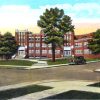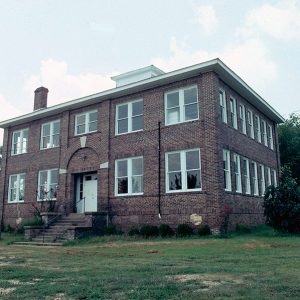calsfoundation@cals.org
King Schoolhouse
The King Schoolhouse is located approximately one mile east of U.S. Highway 71 near the community of King (Sevier County). Built in 1915, the two-story structure is significant for being one of the few surviving school buildings of Colonial Revival style for a railroad community in the county. It was listed on the National Register of Historic Places on June 20, 1996.
In the late 1880s, the settlement that would become the town of King was established. It was not until after 1897, when the Kansas City Southern Railway laid tracks, that the settlement was promoted to town status. King was named after the King Ryder Lumber Company, which operated a company general store and made King a thriving lumber town. At that time, King had four doctors, a drugstore, a railroad depot, a blacksmith shop, two grocery stores, two dry goods stores, a livery stable, a post office, and a dance hall.
The King Schoolhouse was built by J. W. Culp and Son and designed by architect J. H. Bliss of Hope (Hempstead County). It cost the school board $5,000 to construct. The property included two privies that are no longer standing in the twenty-first century and a water pump that is still located in front of the school. The structure’s primary purpose was to be a school building, but it also served the growing town as a community center and church. Classes continued to be held in the building until 1945, when the school consolidated with the school system of the neighboring town of Gillham (Sevier County). In 1986, the Gillham school system consolidated with that of De Queen (Sevier County). Church services continued to be held in the building for a number of years following the closing of the school.
The brown brick-masonry school building is architecturally classified as Colonial Revival. The hipped metal roof is capped with a hipped dormer and vented by two brick chimneys, one between the eastern window bays on the northern façade and the other between the western window bays on the southern facade. All four exterior walls are symmetrical and simple. The main door is centrally placed on the southern façade with stairs leading up. A metal handrail divides the stairs leading to the entrance. The door is white, double-leafed, and slightly recessed within a large brick arch, decorated with concrete keystone and two concrete springer stones. The white, wood-framed windows on the southern facade are lined in pairs on both stories. The east and west facades are identical, with the windows lined on both stories. A single-leaf entrance is located near the center of the northern façade, with windows lined in pairs on both stories. The structure is supported by a brick foundation. On the first floor, a single hallway runs the full length of the building and separates two large classrooms. The second floor contains a single large classroom.
The former King Schoolhouse is owned by Sevier County and used by the Cossatot Arts and Crafts Association as its main facility; the building was purchased for the art center in 1973 for $23,985. The Cossatot Art Center is a nonprofit organization founded in 1973. The organization is active in the community by supporting the annual King Art Show, judging school art competitions, and providing art lessons in nursing homes.
Little renovation to the building has been undertaken since the arrival of the art center. The walls were painted several times, carpet was added to the first-floor hallway, and two restrooms were added in the classroom on the right side of the building. Window panes on the second floor have become loose. An additional building was moved to the property next to the school to serve as the center’s children’s exhibit.
For additional information:
Files of the Sevier County Historical Museum, De Queen, Arkansas.
“King School House.” National Register of Historic Places registration form. On file at Arkansas Historic Preservation Program, Little Rock, Arkansas. Online at http://www.arkansaspreservation.com/National-Register-Listings/PDF/SV0076.nr.pdf (accessed June 5, 2020).
Emily Housdan
El Dorado, Arkansas
 Early Twentieth Century, 1901 through 1940
Early Twentieth Century, 1901 through 1940 Education, Elementary and Secondary
Education, Elementary and Secondary Historic Preservation
Historic Preservation King Schoolhouse
King Schoolhouse 



Comments
No comments on this entry yet.